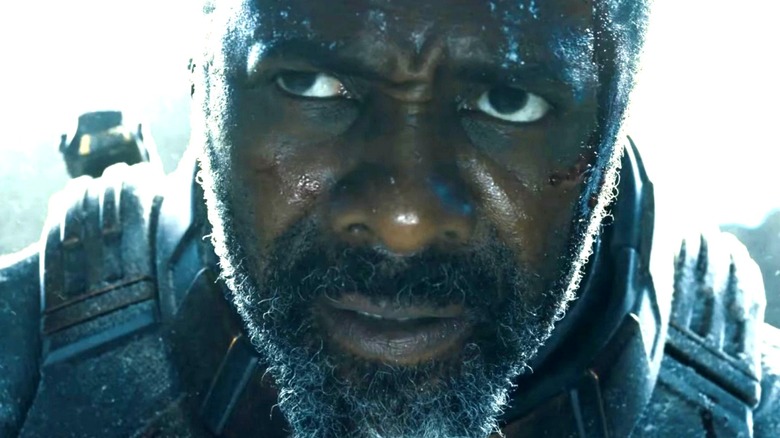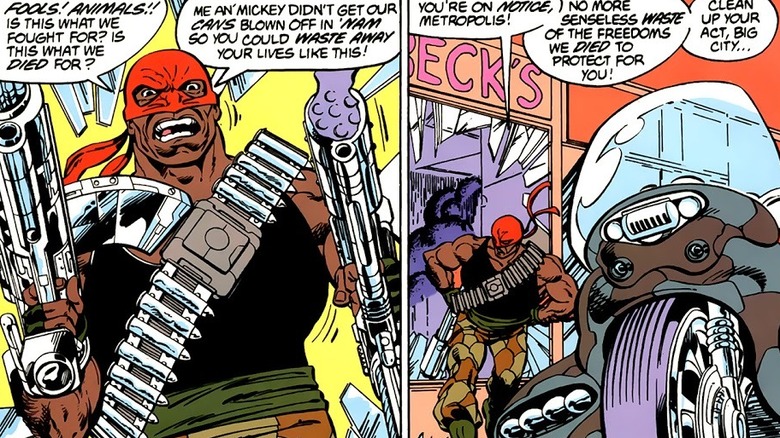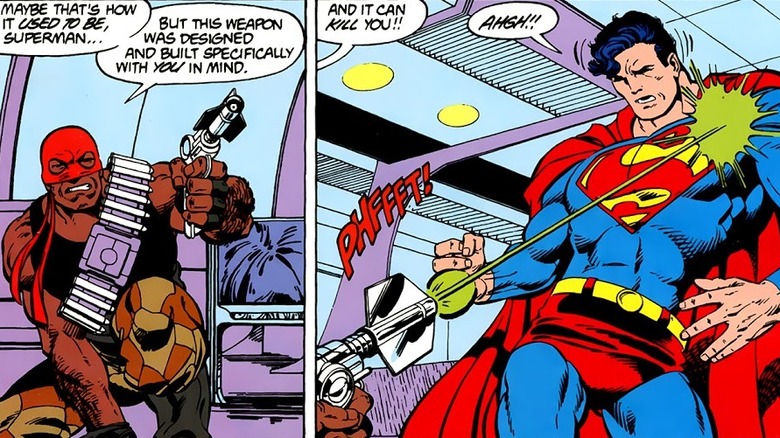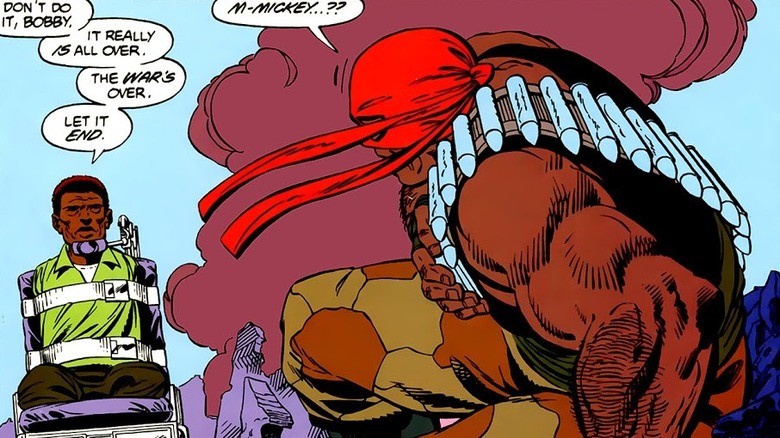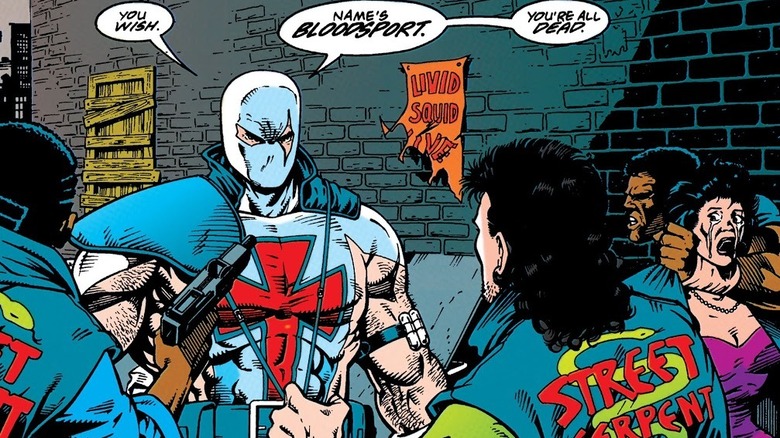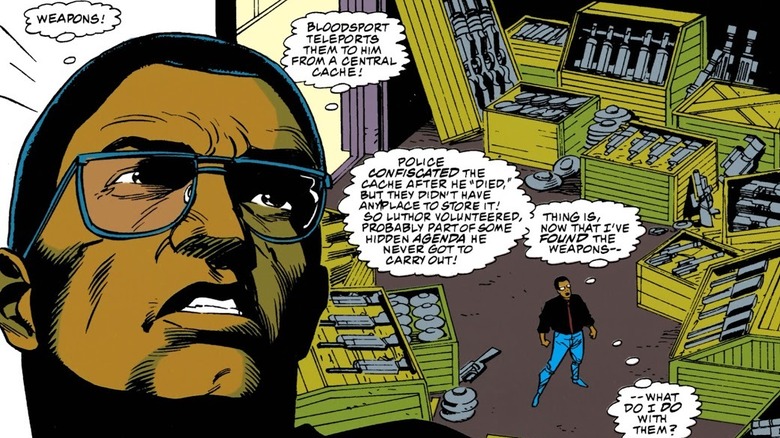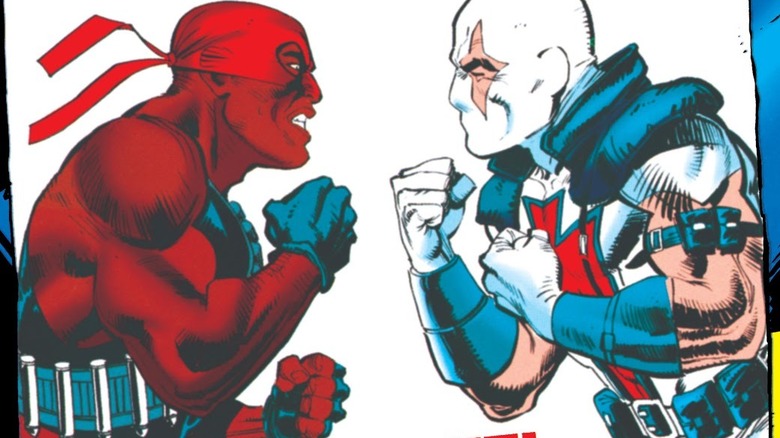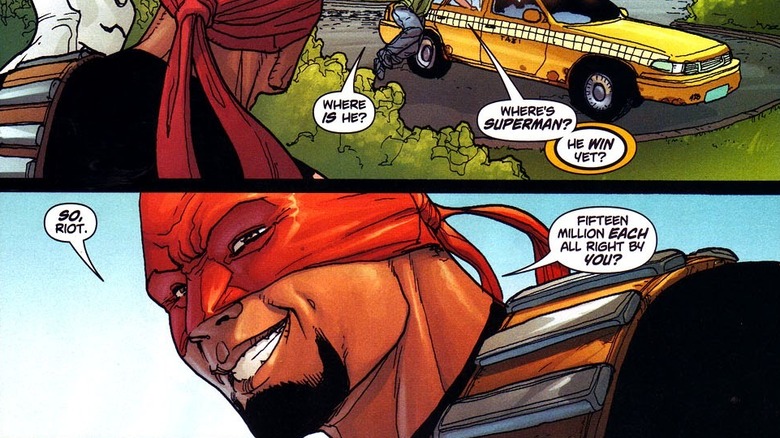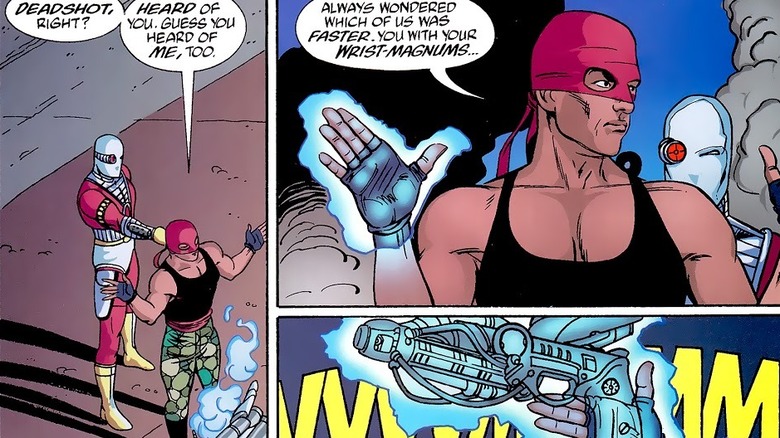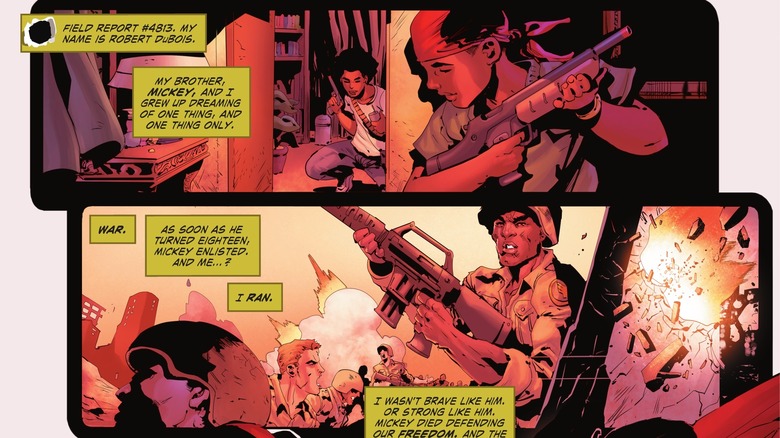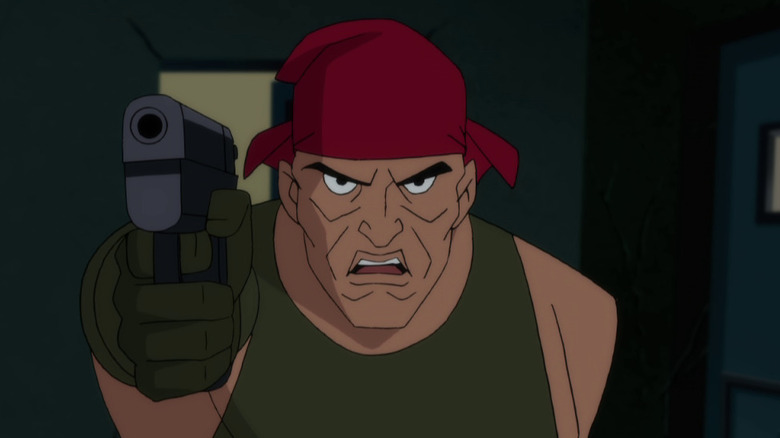The Suicide Squad: Things Only Comics Fans Will Know About Bloodsport
At first glance, it's hard to classify Robert DuBois as a success, even by the charitable standards of fictional supervillains, who by their very nature are fated to lose and fail. His codename, Bloodsport, is bland, and his uniform of a red bandana, black tank top, and camouflage pants does little to distinguish him from the countless other quasi-military combatants who were fashionable in superhero comics from the late '80s to the early '90s. In addition, his initial outing remained his sole appearance for eight years, until he returned to get killed off.
But even with both of his successors as Bloodsport surpassing him in their numbers of appearances, Robert DuBois had one big win that no one could take away from him: He was the Bloodsport who nearly killed Superman.
That was enough for the Robert DuBois version of Bloodsport to replace Deadshot in the live-action Suicide Squad film franchise, after Will Smith became unavailable to return. Now, DuBois is rocking a killer new costume, packing a full-body arsenal of multi-tool weapons, and being played by the super-cool Idris Elba. And yet, comics nerds remember when DuBois, like Norm Macdonald when he was fired from "Weekend Update," wasn't even allowed back in the building.
Buckle up, because this is the comic book history of Robert DuBois and Bloodsport at DC Comics.
Bloodsport is very much a product of the '80s
Two things need to be understood about DC's original Bloodsport: He was created by writer-artist John Byrne for April 1987's "Superman" #4 as both a "done-in-one" character whose story arc was completed within the same issue, and a reflection of the anxieties of the era.
Pop culture in the '80s mirrored America's deeply conflicted feelings about its Vietnam veterans, with both sides of the political aisle coming to a consensus that those vets had been done an injustice by their nation — it's no coincidence that the Vietnam veterans of "The A-Team" were fugitives "for a crime they didn't commit" — even as civilians harbored lingering suspicions that traumatized vets might finally fly into unpredictable episodes of mindless violence (see also: Mel Gibson as police detective Martin Riggs in 1987's "Lethal Weapon").
This matters because John Byrne wasn't just the writer and artist of the then-recently revamped "Action Comics" and "Superman" titles; in the wake of DC's line-wide "Crisis on Infinite Earths" reboot, Byrne was commissioned to produce "The Man of Steel" miniseries in 1986, retelling the origins of Superman and his supporting cast of characters as though they'd been created in contemporary times.
Thus, Lex Luthor became an outwardly respectable Metropolis business mogul, modeled after a certain Manhattan real estate tycoon (and fellow future US president), while Superman gained a single-issue adversary who bore a striking initial resemblance to the Punisher in Marvel Comics and who was driven mad by his "service" in Vietnam (more on that in a minute).
He really did shoot Superman with a kryptonite bullet
Since John Byrne was reintroducing Superman for the "modern" era, he decided to answer a question that smart-aleck comics readers had been asking for decades: Why doesn't some bad guy just shoot Superman with Kryptonite bullets? So, that was exactly what Robert DuBois did, after he'd lured Superman into pursuing him by firing wildly into a restaurant where "Superman's Pal" Jimmy Olsen was having lunch with Lois Lane's younger sister, Lucy.
DuBois proved to be over-prepared, since not only did he come armed with a rifle that fired kryptonite bullets (technically, kryptonite needles), but he also boasted the ability to summon new weapons out of thin air. DuBois' Kryptonite ammunition, and the device that allowed him to teleport an entire arsenal into his hands, were supplied by Lex Luthor, albeit via third-party operatives who allowed Luthor to keep his hands clean. But even the ruthless Luthor balked at DuBois' mounting death toll, since Lex never intended any civilian casualties.
Meanwhile, Superman underwent surgery at a Metropolis hospital to remove the kryptonite splinter, which was complicated by how much his superhuman invulnerability returned as each particle of kryptonite was extracted, forcing the surgeon to weaken Superman through exposure to the same kryptonite in order to suture his wound.
He's not actually a Vietnam veteran
Robert DuBois justified his shooting sprees by screaming about how the civilians of Metropolis were wasting the freedoms that he had ostensibly fought for in Vietnam, echoing Frank Castle's backstory as a disgruntled veteran of the same war. However, the original Bloodsport turned out to have more in common with another Marvel Comics character from the '80s.
In the "G.I. Joe: A Real American Hero" series that Marvel published starting in 1982, it was established that Cobra Commander's older brother had volunteered for repeated tours of duty in Vietnam to spare his younger brother from being drafted. Jimmy Olsen used his skills as an investigative reporter for the Daily Planet to track down the truth about DuBois and his brother and discovered that Bloodsport had a similar backstory. When Robert DuBois received his draft notice, he fled to Canada — not out of conscientious objection to the war, but out of fear — so his younger brother, Michael "Mickey" DuBois, passed himself off as "Bobby," and volunteered to serve in Vietnam in his stead. He survived, but lost both of his arms and legs.
Not only did Jimmy Olsen end Bloodsport's rampage by bringing the DuBois brothers back together, but he also located where Bloodsport was waiting for Superman earlier and used one of Robert DuBois' own cast-off weapons against him. For fans who wondered how Superman would survive a Kryptonite bullet, Byrne's answer was simple: by having a pal like Jimmy Olsen.
His successor was a white supremacist
However tasteful one might consider John Byrne's intended tribute to Vietnam veterans (his tale closed with the caption, "Dedicated to the names on the Black Wall — and those who remember them"), it was unlikely to age well, for the same reason that Marvel's Tony Stark no longer built his original Iron Man suit in captivity in Vietnam.
In 1987, Karl Kesel inked Byrne's pencils for Robert DuBois' debut appearance. Six years later, Kesel had graduated to writing one of the Superman titles, so he and artist Barry Kitson co-created a new Bloodsport for "Adventures of Superman" #507 in December of 1993. While the value of the "Bloodsport" name remains suspect outside of Jean-Claude Van Damme fandom, the device that allows Bloodsport to draw weapons out of subspace like a video game character was admittedly far too cool for DC to let it lie fallow, but the direction Kesel and Kitson chose for the second Bloodsport was more than a bit cringeworthy.
Alexander Trent's father was the sheriff of the fictional Southern town of Melonville, while his mother was a member of the Aryan Brotherhood who'd allowed herself to be experimented on while she was pregnant in an effort to breed a "White Superman." When Trent made his debut as Bloodsport II in Metropolis' Suicide Slum, he dressed for that role in an almost all-white unitard, accented by a modified red "Iron Cross" on his chest.
Bloodsport II's real nemesis was the Daily Planet
Alexander Trent was viscerally nasty, with his stated aim of killing as many Black, Latino, and Jewish people as possible, in addition to "race traitors" and aliens (both immigrants from other countries and literal extraterrestrials), and his origin story came uncomfortably close to affirming the same eugenics theories that the character's creators no doubt intended to decry.
But in spite of griping over "losing a job because of a quota," and having a son who "idolized a basketball star" more than him, Trent's most significant grievances should have been with the Daily Planet, since a journalistic exposé by a young Perry White and Franklin Stern — the future editor-in-chief and the publisher of the Planet, respectively — led to the death of Trent's father and the arrest of his mother.
Likewise, while young Daily Planet reporter (and Lucy Lane's future husband) Ronald Troupe couldn't fire a gun at Trent, he defeated Bloodsport II in "Action Comics" #702 by finding and destroying the hidden cache of weapons that Trent received from the demon Bloodthirst, because '90s comics were super-creative with characters' names.
Amusingly, Trent was enraged when Bloodthirst supplied fellow supervillain Hi-Tech with similar weapons-teleporting technology, even though she used it to save him from Superman, so one can only imagine his reaction if he'd seen the vigilante Demolitia, aka Latin American immigrant Marita Chavez, using the same teleporter in 1996's "Action Comics" #718.
Both Bloodsports fought in a boxing match refereed by Superman
Eight years after his debut, the original Bloodsport, Robert DuBois, finally made his second appearance on the printed page in "Adventures of Superman" #526, when he was transferred to Stryker's Island Penitentiary in Metropolis, where Bloodsport II was already incarcerated.
Because superhero comics follow so many of the same narrative rules as professional wrestling, the warden passively allowed his inmates to stage and promote a boxing match between DuBois and Trent in the prison gym, since the best way to defuse simmering racial tensions within a population of convicted criminals is to shrug one's shoulders as they print up posters for the prelude to an all-out race war.
To his credit, Superman pointed out what a catastrophically terrible plan this was even while agreeing to referee the fight. Sure enough, Trent managed to activate his still-implanted weapons teleporter to summon a "Toastmaster," a highly advanced firearm invented by former substitute Superman John Henry Irons, aka Steel (and yes, even as a white supremacist, Trent couldn't help swiping tools first used by Black guys).
This tragic twist on Thunderdome saw two men enter and neither one leave, as DuBois was gunned down by prison guards for attempting to escape, while Trent's own Aryan Brotherhood lit him on fire in his cell with a Molotov cocktail after they learned that DuBois briefly had Trent at his mercy during the chaos that followed their boxing match.
The third Bloodsport failed to make a splash
By the time they both died, Robert DuBois had appeared in two comics, while Alexander Trent had appeared in five. However, a third Bloodsport appeared in six issues without dying, in spite of not even being named aside from his costumed alias.
Writers Kurt Busiek and Geoff Johns and artist Pete Woods co-created Bloodsport III for "Superman" #652 in July of 2006, and while both DuBois and Trent had well-defined motivations, what was most notable about the FNG (a military term we'll say stands for "Freakin' New Guy") was, ironically, how much he didn't stand out, in either his motivation or appearance. Bloodsport III seemed driven by little more than petty greed, and while he occasionally sported a chin-scruff goatee and a black T-shirt (as opposed to DuBois' clean shave and black tank top), his look was largely indistinguishable from the original Bloodsport, save for slightly more ethnic ambiguity in his skin tone and facial features.
The closest Bloodsport III came to character-defining relationships were his recurring work for the Metropolis-based criminal organization Intergang, and his alliance of convenience with Superman Revenge Squad member Dr. Frederick von Frankenstein, aka the self-duplicating supervillain Riot. In his initial outing, when Intergang offered a $30 million bounty to whomever could kill a recently returned Superman, Bloodsport III offered to split the reward 50/50 with Riot alone.
Bloodsport fought Deadshot in a duel
In superhero comics, a character's death doesn't preclude them from actively appearing in stories. Alexander Trent appeared as the easily-dispatched opening foe in "Superman: The Man of Steel" #129 in October of 2002, a flashback tale focusing on Superman's friendship with a Metropolis police officer. Robert DuBois appeared in a grand total of two pages (and five panels of art) as part of a seemingly random assemblage of supervillains in the Kurt Busiek-written "Avengers/JLA" #3 in December, 2003, during a temporary mashup of the Marvel and DC Comics universes that also played havoc with their respective histories.
But the one that's relevant to "The Suicide Squad" fans is the Karl Kesel-written "Batman & Superman: World's Finest" #10, which pitted former Squad member Deadshot, played by Will Smith in 2016's "Suicide Squad" film, against future Squad member Robert DuBois, whom Idris Elba plays in 2021's "The Suicide Squad" as Deadshot's functional replacement.
Kesel, who'd written DuBois' death five years prior, brought together the original Bloodsport and Deadshot in a tale of tandem breakouts from Stryker's Island in Metropolis and Arkham Asylum in Gotham, orchestrated so the Stryker's Island inmates could stage a takeover of Gotham, while the Arkham Asylum escapees would do likewise in Metropolis. The two marksmen engaged in a quick-draw contest, after Deadshot let Bloodsport know he didn't appreciate the Metropolis shooter muscling in on his turf in Gotham. Ultimately, Batman and Superman teamed up to swiftly disarm them both.
His comic book revamp owes a lot to The Suicide Squad
Because DC Comics' continuity is as Swiss-cheesed as Dr. Sam Beckett's memories in "Quantum Leap," the company did not hesitate to capitalize on James Gunn including Robert DuBois as Bloodsport in "The Suicide Squad." While DuBois' resurrection-slash-reboot was already marked with cameo appearances in 2019's "The Flash" #61 and #62, his revised origin wasn't established until "Suicide Squad" #5 in September of 2021.
Although the rebooted DuBois traded up to snazzier duds, topped off with a helmet that married the aesthetics of Marvel's Taskmaster with the Xenomorphs from the Alien franchise, his original red bandana remained a part of his in-universe history, as did his brother Mickey. To avoid aging DuBois, Vietnam was erased from his backstory, which also no longer made him a draft-dodger. Instead, Robert's bond with Mickey was emphasized by showing them playing at being soldiers when they were growing up, which made it a more personal betrayal when Robert failed to enlist alongside an 18-year-old Mickey.
To prevent Jimmy Olsen from repeating history by reuniting Robert with a war-wounded Mickey as adults, thereby weakening his resolve as Bloodsport, Robert's updated origin elevated Mickey to a casualty of war, preventing any healing reconciliation between the DuBois brothers. In addition, after Robert DuBois' original rampage as Bloodsport was halted in Metropolis, he was sent to the same Belle Reve Penitentiary that served as a base of operations for Amanda Waller's Task Force X and Suicide Squad.
He's been played by both Stringer Bell and SpongeBob Squarepants
For further evidence that DC had no clue what to do with Bloodsport before James Gunn tapped the character for big-screen stardom, consider that the 2004-2006 "Justice League Unlimited" animated series featured Robert DuBois in only three episodes, none of which afforded him a speaking role. When a voice actor was finally cast to play Bloodsport, it was Tom Kenny, best known as the voice of SpongeBob SquarePants. Granted, Kenny also voiced Deadshot in three episodes of the "Batman: The Brave and the Bold" animated series (among other characters on the show), but that's not quite on the same wavelength as Idris Elba playing Stringer Bell on HBO's "The Wire."
In the 2019 direct-to-video "Justice League vs. the Fatal Five" animated film, Kenny played Bloodsport as a bizarre hybrid of both of his most notable incarnations from the comics. The character was named "Alexander Trent," but he wore a red bandana and military fatigues reminiscent of Robert DuBois. Rather than spouting white supremacist hate-speech, Kenny's Bloodsport espoused extreme conspiracy theories, such as insisting that the assassination of President Kennedy had been a hoax, which got him locked up in Arkham Asylum. Bloodsport fared better in "Girl of Steel," the 2017 third-season episode of the "Supergirl" live-action series, in which David St. Louis played Robert DuBois as a serious threat.
